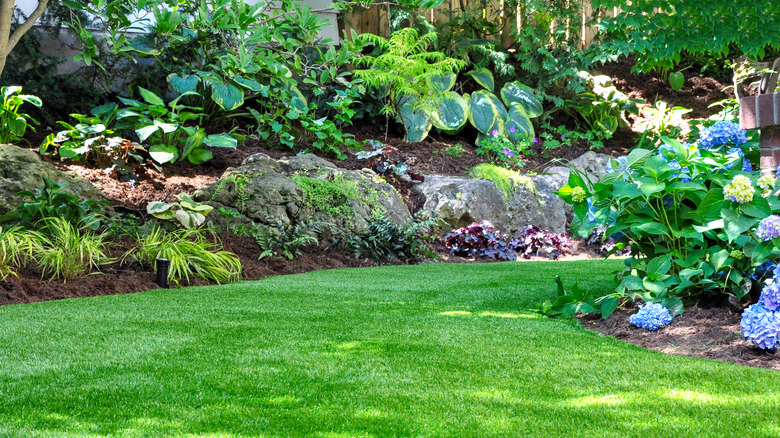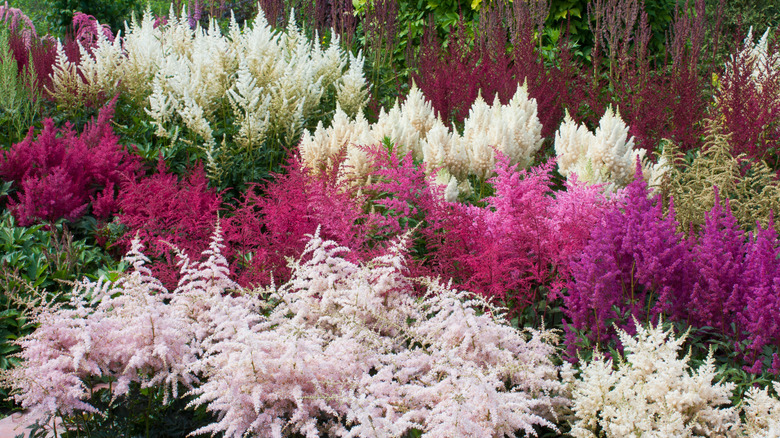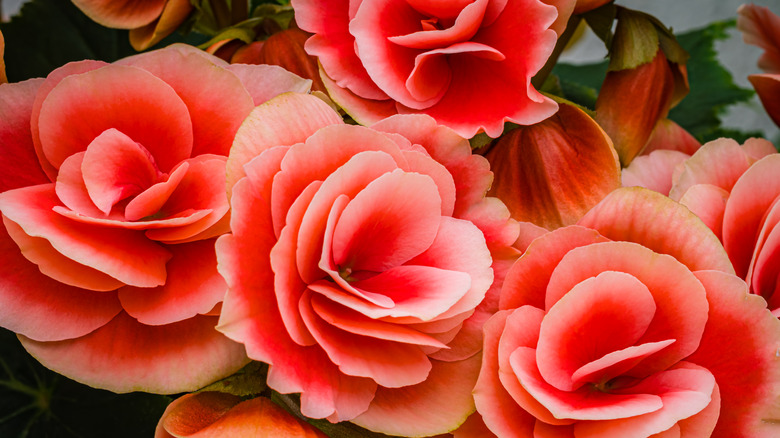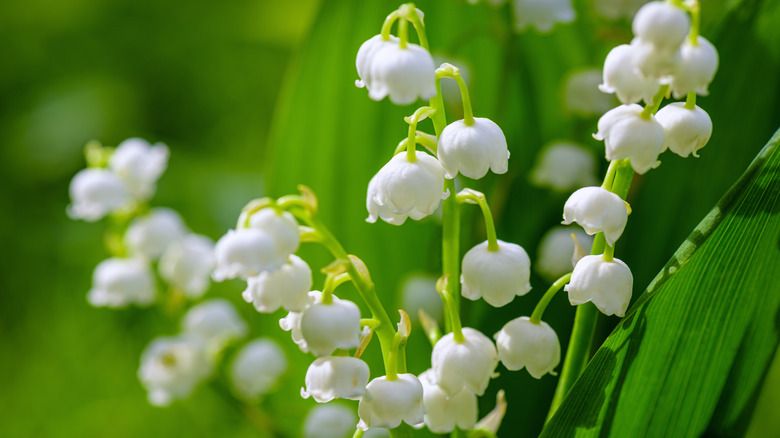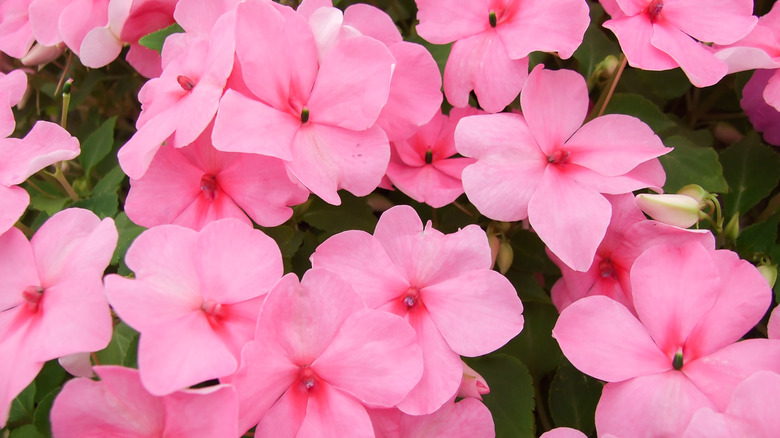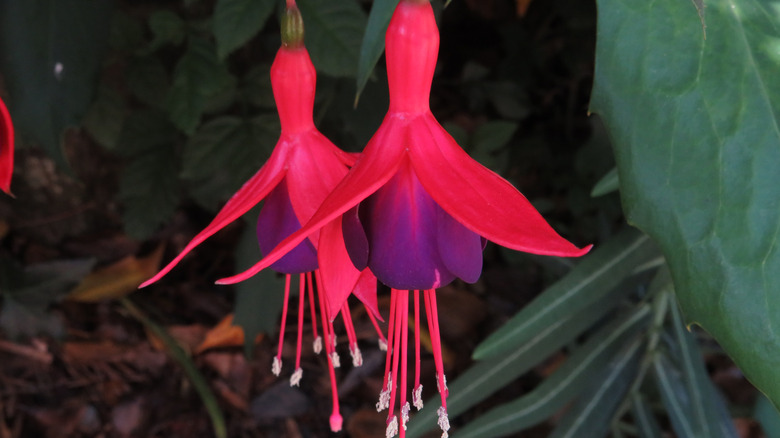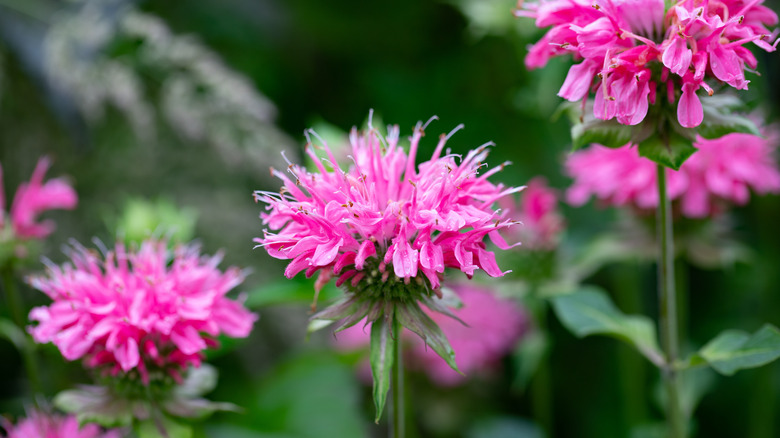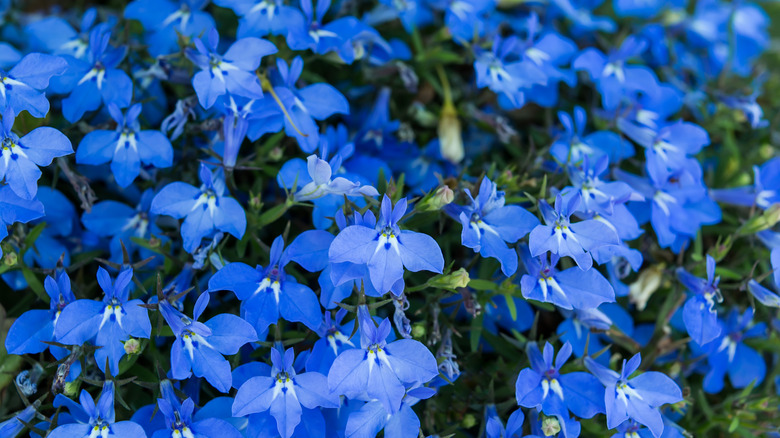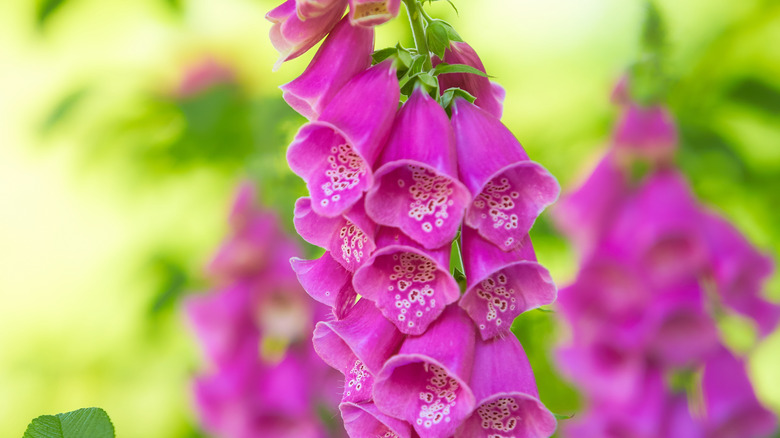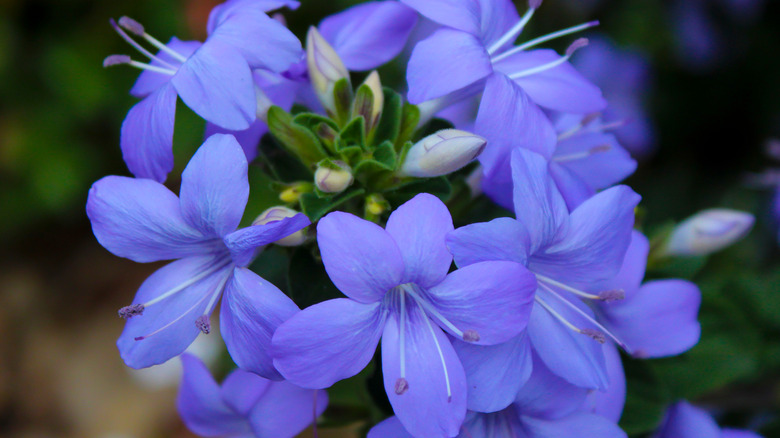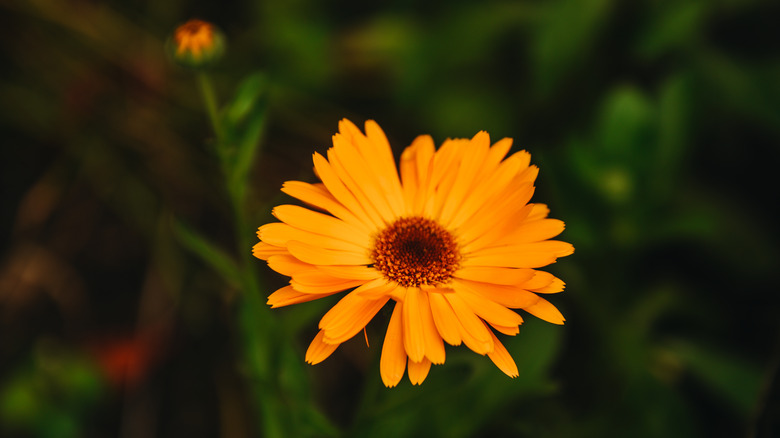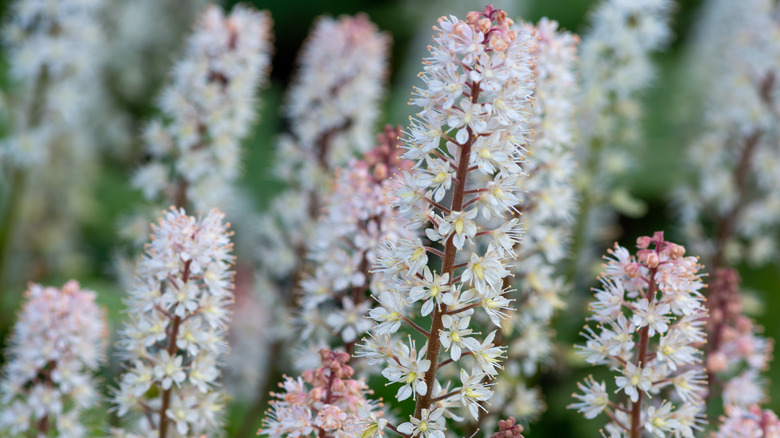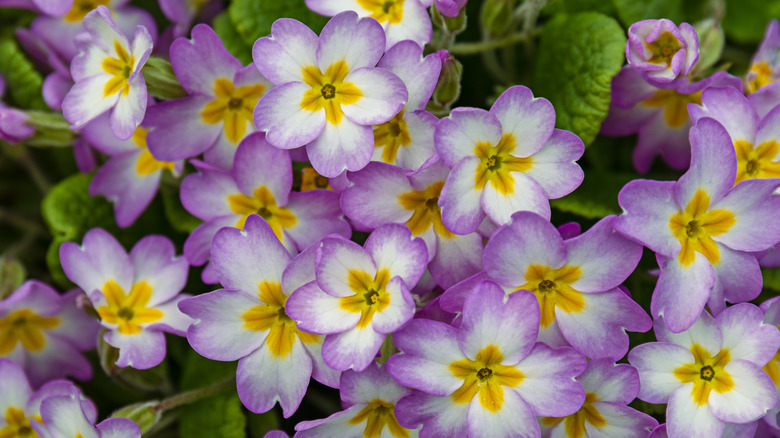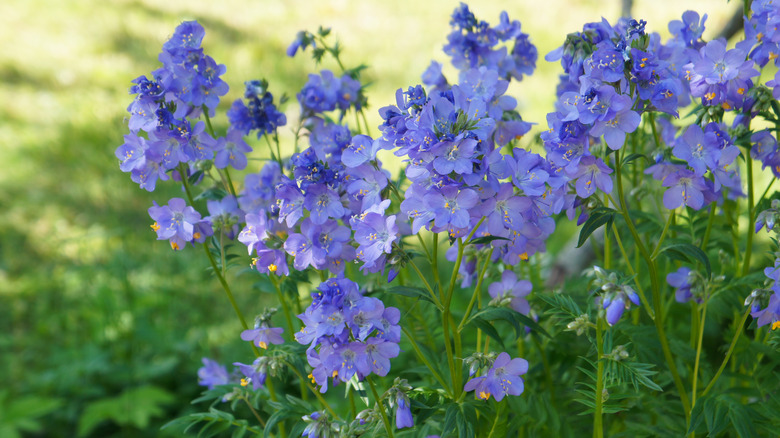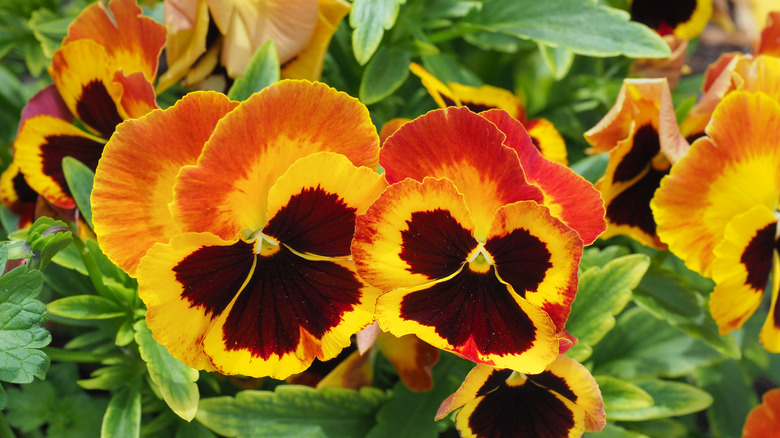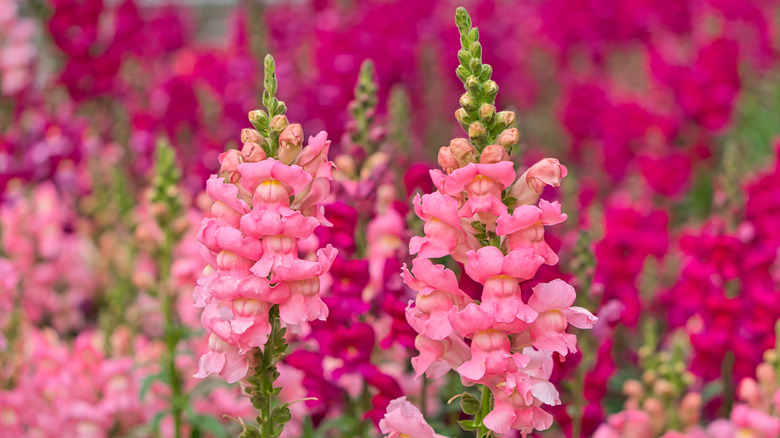15 Beautiful Flowers That Grow Perfectly In Shade
When it comes to planning a garden and choosing desirable plants to put in it, shade can get sometimes a bad rap. That's because people tend to focus more on the amount of sunlight a certain patch of land will receive and how to optimize it. And while it goes without saying that sunshine indeed is a crucial ingredient in overall plant health, don't give up hope if your landscaping doesn't allow for much light. There are actually quite a few flowers that will group together perfectly without much help from the sun!
To that end, we at House Digest have rounded up the most stunning flowers among them so that you can plan and plant a vibrant, captivating shade garden. So without further ado, here are 15 beautiful flowers that grow perfectly in shade, and everything you need to know in order to cultivate them. Get your green thumb ready!
1. Astilbe
With plumey flowers sometimes described as cotton candy-esque, astilbe (scientific name astilbe) is a delightful perennial that will add height, texture, and interest to your shade garden. Depending on the variety, their height can range from 8 inches to 4 feet, according to Garden Design. Astilbe plants come in shades of pink, white, purple, and red. Once established, they're relatively low-maintenance.
Bloom Season: wide range depending on the variety, early spring to mid-to-late summer
USDA Growing Zone: 3 to 9
Growing Conditions: partial sun to full shade
Soil Type: moist, nutrient-rich soil with a layer of mulch
Size: 8 inches to 4 feet
2. Begonia
An annual that provides nonstop blooms all summer, begonias (scientific name begonia) are a longstanding favorite to use in window boxes, hanging baskets, and containers — but don't think that's where their talent ends. If you want to plant them in your shade garden, they'll still deliver that nonstop color and pair beautifully with other shady favorites like hostas. You can choose from varieties that mound, trail, or remain upright. They come in shades of yellow, white, orange, pink, and red, and their leaf texture changes drastically between varieties, per The Spruce.
Bloom Season: all summer and can be overwintered inside
USDA Growing Zone: 9 to 11
Growing Conditions: full sun to full shade
Soil Type: moist and well-draining
Size: varies between types
3. Lily of the Valley
Known for its intoxicatingly sweet scent, lily of the valley (scientific name convallaria majalis) is a perennial that thrives in the shade. Getting married soon? It's a popular choice for wedding bouquets — even Kate Middleton used it in hers. If you're familiar with its habit of overtaking a garden patch, Garden Design says there are newer cultivars available that aren't nearly as invasive. With long lasting flowers in the spring and red berries in the winter, lily of the valley will reward you by adding interest to your garden across various seasons.
Bloom Season: mid to late spring
USDA Growing Zone: 2 to 7
Growing Conditions: full to partial shade
Soil Type: moist, well-draining, and amended with nutrients
Size: 6 to 18 inches
4. Impatiens
When you're looking for an annual that will give you nonstop blooms and add a burst of color to your shade garden, look no further than impatiens (scientific name iImpatiens walleriana). Available in shades of pink, purple, red, white, and yellow, they're a low-maintenance, cheerful flower, per The Spruce. Depending on the variety you choose, some impatiens have large blooms, while others are double-flowered or have more unique foliage. They look great in containers and in the ground, so you're not limited there. Make sure they get plenty of water during any droughts, and keep your eyes peeled for downy mildew, as it can wipe out your impatiens for the rest of the season.
Bloom Season: late spring through to first frost
USDA Growing Zone: 2 to 11
Growing Conditions: full to partial shade (though some varieties will tolerate more sun)
Soil Type: moist and well-draining with a layer of mulch
Size: varies between types
5. Fuchsia
If you hear the word "fuchsia," your brain may immediately think of the color, but did you know there's a flower by the same name that comes in thousands of varieties? Unique and eye-catching, fuchsia (scientific name fuchsia) blooms drop and dangle. You can find them in shades of purple, pink, white, red, and yellow, with trailing, vining, or mounding behaviors across the varieties. According to Gardening Know How, fuchsia performs especially well in hanging baskets and planters. You want it to place fuchsia somewhere in your garden where its unique flowers will be appreciated. Overall, they don't hold up well in intense summertime heat (even in the shade), so make sure to keep a close eye on them as the temperatures rise.
Bloom Season: late spring through mid summer
USDA Growing Zone: 6 to 11
Growing Conditions: full to partial shade
Soil Type: moist, cool, and well-draining
Size: varies between types
6. Bee Balm
Like its name suggests, perennial bee balm (scientific name monarda) is beloved by pollinators. A member of the mint family, some know it better by the common name "bergamot." Available in shades of pink, red, lavender, and white, bee balm's blooms have a slightly scraggly, pom-pom appearance. Both its leaves and flowers have a wide range of uses in tea, medicinal rubs, potpourri, and even natural mosquito repellent, says Garden Design. Whether you want to incorporate bee balm in with your other herbs, use it in a cutting garden, or add it to containers, it should thrive in any of those locations — but it does grow quickly, so plan accordingly for its expansion.
Bloom Season: late spring to fall
USDA Growing Zone: 3 to 9
Growing Conditions: partial shade to sun
Soil Type: can tolerate most soil, but prefers well-draining and slightly acidic
Size: 10 inches to 4 feet
7. Lobelia
Delicate, small blue flowers aren't very common in the floral world, so if this is what you're after, let's give you the lowdown on lobelia (scientific name lobelia). They're most commonly grown as annuals and used in containers or hanging baskets. However, according to Garden Design, there are over 400 varieties of lobelia, so you can find perennial versions, ones that mound instead of trail, and other colors like purple, red, and pink. Once they're established, you don't have to do much in terms of care. Even deadheading isn't necessary because the plants self clean. As summer progresses, most types of lobelia prefer the cool protection of shade and their blooms may suffer if you leave them in direct sun.
Bloom Season: spring to fall
USDA Growing Zone: annual in all zones but perennials will vary
Growing Conditions: partial shade to full sun
Soil Type: moist and slightly acidic
Size: 12 inches to 4 feet, depending on variety
8. Foxglove
With flowers shaped like little bells, foxglove's (scientific name digitalis) unique appearance — and impressive height of almost 6 feet — makes it a wonderful statement piece for any garden. Most varieties are perennials (though they don't have a long lifespan) or biennials. They come in shades of pink, yellow, purple, white, and even bicolored and speckled. Depending on where you live, some varieties can tolerate more sunlight but most do well in partial to full shade. You'll want to make sure to add stakes for support if you choose a variety that grows especially tall, suggests Gardening Know How. A word of warning: foxglove is highly toxic to children and pets, so keep it far from their reach.
Bloom Season: late spring to early summer
USDA Growing Zone: 4 to 10
Growing Conditions: full shade to partial sun
Soil Type: moist, well-draining, and enriched with nutrients
Size: 2 to 6 feet, depending on variety
9. Browallia
Sometimes commonly referred to as a bush violet, browallia (scientific name browallia) blooms are a gorgeous shade of bluish purple. They're drought resistant and will flower all summer long. Most grow it as an annual, but according to Better Homes & Gardens, you can actually overwinter browallia inside with great success and then put it back outside the following summer. Browallia loves the shade, and its beautiful color absolutely pops against other green foliage. You can use it in containers or as an edging plant in your flower beds.
Bloom Season: late spring to fall
USDA Growing Zone: 9 to 11
Growing Conditions: full shade to partial sun
Soil Type: moist with occasional fertilizing
Size: 1 to 3 feet
10. Calendula
With cheerful yellow or orange blooms and a long history of medicinal uses, there's a lot to love about calendula (scientific name calendula officinalis). It's commonly known as pot marigold, but it is not the same plant as the traditional marigold. Grown as an annual, calendula performs best in cooler temperatures with partial shade. In fact, American Meadows says that it might stop blooming during the hottest days of summer, but begin again as the weather transitions to fall (as long as you provide consistent deadheading and watering). While it looks great in containers or in the ground, you may want to consider adding some to your vegetable garden because calendula helps draw aphids away from your veggies (via Gardening Know How).
Bloom Season: spring through fall
USDA Growing Zone: 2 to 11
Growing Conditions: partial shade to partial sun
Soil Type: well-draining and moist but not soggy
Size: up to 15 inches
11. Foamflower
With a name that evokes images of effervescence and cheerfulness, the foamflower (scientific name tiarella) is another unique choice that's perfect for a shady patch in your garden. It's a perennial that blooms early in the spring, bringing a puff of pink and white to a landscape that's likely still gray and drab. Foamflowers are native to a woodlands environment, so that's why they perform so well in the shade. If you give them any sunlight, just make sure it's morning light and not the harsher, hotter afternoon sun, says Gardening Know How. They pair beautifully with other shade lovers like ferns and hostas.
Bloom Season: spring through early summer
USDA Growing Zone: 3 to 8
Growing Conditions: full to partial shade
Soil Type: well-draining and enriched with nutrients
Size: up to 1 foot
12. Primrose
With small, adorable clusters of brightly-colored flowers, primroses (scientific name primula vulgaris) are a popular choice for livening up any shade garden. A perennial that's available in shades of blue, red, pink, green, orange, yellow, and white, it's one of the earliest blooming spring flowers, according to Better Homes & Gardens. There are over 400 varieties of primrose, so you shouldn't have any trouble finding the perfect size and color to fit your garden. They're not picky or high-maintenance plants, which means they'll do well in containers, your garden bed, or even as an indoor plant. While the exact sunlight requirements depend on the variety you choose, most primrose perform best in partial to full shade, while some can tolerate a little bit more sunlight.
Bloom Season: spring (though some varieties can last until fall)
USDA Growing Zone: 2 to 8
Growing Conditions: full to partial shade
Soil Type: moist, well-draining
Size: varies based on type
13. Jacob's Ladder
If you're looking for a low maintenance perennial in a lovely shade of bluish purple, Jacob's Ladder (scientific name polemonium caeruleum) is an excellent choice. It gets its name from the unique, ladder-like shape of its leaves, says the Gardening Channel. While the bluish purple shade is most common, you can also find varieties with white flowers and others that have a pink tint to them. Jacob's Ladder thrives in shaded areas, as too much sunlight will scorch its delicate leaves. Even if you live in the suburbs, adding this flower to your garden can give it a lovely woodland feel.
Bloom Season: late spring to early summer
USDA Growing Zone: 2 to 9
Growing Conditions: full to partial shade
Soil Type: moist, well-draining, amended with compost
Size: up to 30 inches
14. Pansy
A familiar favorite that pops up in garden centers during the spring and fall, pansies (scientific name viola tricolor var. hortensis) are known for their rainbow of colors, easy care, and face-like design on the petals. You can find these annuals in shades of yellow, purple, orange, red, white, burgundy, or multi-colored. Whether you want to plant pansies in your flower bed or containers, they'll fare well in either spot. According to The Old Farmer's Almanac, they actually prefer cooler weather and don't do well in the throes of summer's heat. This also makes them an ideal planting choice for any partial shade needs in your garden.
Bloom Season: spring through fall
USDA Growing Zone: 4 to 11
Growing Conditions: partial shade to sun
Soil Type: moist, well-draining
Size: 6 to 9 inches
15. Snapdragon
Grown by most gardeners as annuals, snapdragons bring a variety of colors and mid-level height to pots and flower beds. Plant Care Today says their height can range from 6 to 36 inches tall. For the healthiest plants, make sure to leave a minimum of 6 inches between plants to allow for optimum air circulation. If you like pastel shades in your garden, you're sure to find a snapdragon that's perfect for it. As a double bonus, butterflies love snapdragons and they make great cut flowers for bouquets. Depending on the variety you choose, some snapdragons perform better than others in partial shade, so just check the care tag before planting.
Bloom Season: spring through summer
USDA Growing Zone: 7 to 11
Growing Conditions: partial shade to full sun
Soil Type: rich, well-draining, and moist
Size: 6 to 36 inches
